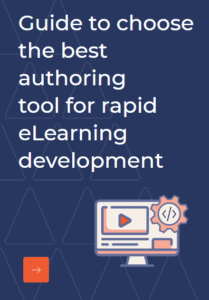Working in the eLearning Industry? Then those terms need no explanation. Usability and Motivation are inevitably the components that make great eLearning. But, as with many terms the definitions often need clarity and in this case the range of overlap or inter-relationship needs exploration.
To answer the question, let’s start from the basics.
What is Usability?
According to Wikipedia, “Usability is the ease of use and learnability of a human-made object such as a tool or device. In software engineering, usability is the degree to which a software can be used by specified consumers to achieve quantified objectives with effectiveness, efficiency, and satisfaction in a quantified context of use. ISO defines usability as the extent to which a product can be used by specified users to achieve specified goals with effectiveness, efficiency, and satisfaction in a specified context of use. The word "usability" also refers to methods for improving ease-of-use during the design process.”
What is Motivation?
By definition, “Motivation is the reason for people's actions, desires, and needs. Motivation is also one's direction to behavior, or what causes a person to want to repeat a behavior. An individual is not motivated by another individual. Motivation comes from within the individual. Motivation in learning (education) can have several effects on how students learn and how they behave towards subject matter. It can:
- Direct behavior toward particular goals
- Lead to increased effort and energy
- Increase initiation of, and persistence in, activities
- Enhance cognitive processing
- Determine what consequences are reinforcing
- Lead to improved performance.”
The Correlation
Very often in case of eLearning the self-motivation is influenced by the ease of use too, this is where usability comes into picture. As mentioned in a Dissertation thesis by Ying Hu, submitted to the Virginia Polytechnic Institute and State University,“First, both motivational design and usability engineering have the primary goal of enhancing learners’ experience and performance in the online teaching-learning environment. Second, both can evaluate the learner’s experience and interactions with the learning interface. Usability usually focuses on effectiveness, efficiency and learner satisfaction (ISO 9241-11, 1998; ISO/IEC 25062, 2006); while learner motivation can be assessed through attention, relevance, confidence and satisfaction (Keller, 1987a, 1987c).”
So, where do Motivation and Usability converge. As eLearning designers, it is often experienced that motivation is given preference over usability. Usability often comes after all the aspects of intrinsic motivation are considered. This approach mostly piggybacks on Fogg’s Behavior Model, that shows that three elements must converge at the same moment for a behavior to occur: Motivation, Ability, and Trigger. So, ideally when the learner’s intrinsic motivation is higher, the tolerance for unsatisfactory usability would increase. Learners with the drive to learn would often find ways to keep learning despite any issues in the learning product. Whereas learners who are reluctant to learn either due to lack of motivation or less competence in the subject matter, would look for better usability to balance their ability to make learning easier. So, it can nearly derive that Usability and Motivation may be inversely proportional to each other.
While Usability and Motivation may influence each other, both are critical in learning design. Many components of interface design like appearance, graphics/multimedia, navigation, page layout, text appearance, and paging/scrolling etc. are closely linked with motivation components. Usability is an important aspect considering the complexity of modern devices and it hinges mostly on the external appearance, the interface and navigation of the eLearning. Motivation on the other hand depends on good instructional strategies, relevant and interesting content and not just usability.
As mentioned by Ying Hu, “In a self-paced online learning environment, a usable and motivating interface is desirable for learners; however, creating such an interface can be challenging for designers. Both motivation research and usability studies have endeavored to improve the design of online instruction and enhance learners’ learning experience, from different perspectives. While a few discussions have been documented in literature involving motivation or usability concepts into one another (Shilwant & Haggarty, 2005; Zaharias, 2006), little empirical evidence is available to demonstrate how motivational design and/or usability improvements may affect learners’ learning experience. Few studies have been conducted to show how motivation and usability methods may work together in computer-based learning environments, especially in the relatively new but rapidly growing field of online learning.” So to conclude Usability while designing eLearning projects does have a huge role to play and is definitely an important factor to determine the success of the course.



